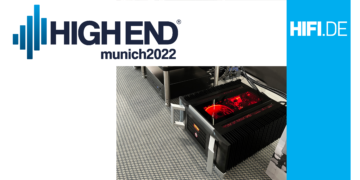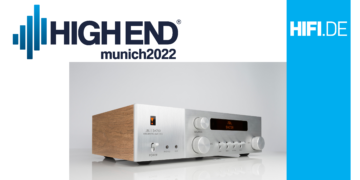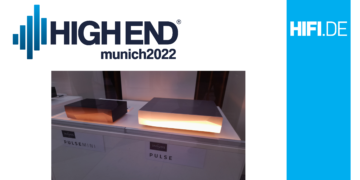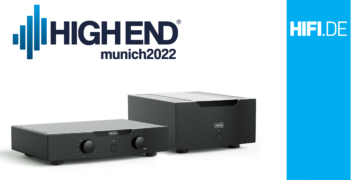| HIFI-FORUM » PC, Netzwerk & Multimedia » PC & Hifi » USB-Stereo Soundkarte ohne resampling 44,1 auf 48 ... | |
|
|
||||
USB-Stereo Soundkarte ohne resampling 44,1 auf 48 khz+A -A |
||||
| Autor |
| |||
|
wayan
Neuling |
#1
erstellt: 21. Apr 2007, 17:00

|
|||
|
Hallo, ich suche eine Soundkarte, die ohne Resampling von 44,1 auf 48 khz die digitalen Daten optisch oder elektrisch an meinen hochwertigen D/A-Wandler des Hifi-Amp weiterreicht. Der Laptop hat eine eingebaute Karte (AC97), die den Datenstrom auf 48 khz hochrechnet. Da ich meine CD-Sammlung verlustfrei archivieren möchte, geht es mir um um beste Audioqualität, ohne Eingriffe der Soundkarte. Da mein Laptop weitgehend arbeitslos ist, will ich ihn als Quelle mit USB- Festplatte nutzen. Bislang verwende ich I-Tunes für die MP3 Sammlung - werde dann wohl auf einen universelleren Playersoftware umsteigen müssen, die auch Flac beherscht. (WinAmp?) Grüße und Danke Wayan |
||||
|
wayan
Neuling |
#2
erstellt: 11. Mai 2007, 23:00

|
|||
|
Hallo, hat denn niemand eine Empfehlung. War heute bei einem Händler, der auch nicht weiter wusste. Würde mich über einen Tip sehr freuen, Danke Wayan |
||||
|
|
||||
|
gr1zzly
Inventar |
#3
erstellt: 11. Mai 2007, 23:42

|
|||
|
Hi, jede gängige USB-Soundkarte der Pro-Audio Hersteller sollte gehen, zB M-Audio Transit. Als Player eignen sich Winamp oder foobar2000. |
||||
|
wayan
Neuling |
#4
erstellt: 28. Mai 2007, 22:18

|
|||
|
Danke, für die Antwort. Wayan |
||||
|
WURSCHTELPETER
Stammgast |
#5
erstellt: 28. Mai 2007, 22:41

|
|||
|
hi wenn du es richtig gut haben willst,AQVOX.kommt natürlich drauf an,was du ausgeben willst.aber du schreibst ja beste audioqualität,dann solltest du dir das event. mal ansehen. gruss w. |
||||
|
lini
Inventar |
#6
erstellt: 29. Mai 2007, 00:00

|
|||
Genau lesen: Den Wandler hat Wayan schon. Was er jetzt noch braucht, ist einen vernünftigen SPDIF-Output für seinen Rechner. Grüße aus München! Manfred / lini |
||||
|
Nattydraddy
Inventar |
#7
erstellt: 08. Jul 2007, 21:20

|
|||
|
Z.B. die Trends Audio UD-10:
Aus einem Blog-Eintrag:
|
||||
|
mssm
Stammgast |
#8
erstellt: 03. Mai 2010, 12:34

|
|||
Zwar etwas länger her... Warum SPDIF? Der AQVOX kann doch per USB als PC-Hardware verwendet werden. |
||||
|
mssm
Stammgast |
#9
erstellt: 03. Mai 2010, 12:49

|
|||
|
Zum gleichen Thema habe ich eine ähnliche Frage: Welche Nachteile bringt das Resampling? Ich habe über SPDIF ein PowerBook an die Vorstufe gehangen. Auch bei 44,1kHz Dateien erkennt die Vorstufe 48kHz. Die Soundkarte scheint also ein Upsampling zu machen. Gibt es Chancen, dass die Soundkarte beides kann, 44,1 und 48 kHz und es nur eine Software-Einstellung ist? Betriebssystem ist Linux.  15inchPowerBookG4 developer notes besagt auf S. 53, dass an Samplingraten zur Verfügung steht: 32, 44.1, 48, 64, 88.2, und 96 kHz 15inchPowerBookG4 developer notes besagt auf S. 53, dass an Samplingraten zur Verfügung steht: 32, 44.1, 48, 64, 88.2, und 96 kHzEs sollte also eine Softwareeinstellung sein, wofür ich dann in anderen Gruppen anfrage.. Nebenbei sehe ich, dass selbst einfache USB-Soundkarten wie die  Terratec Aureon Dual USB 44.1 und 48 kHz anbieten, so eine habe ich auch noch zur Verfügung. Terratec Aureon Dual USB 44.1 und 48 kHz anbieten, so eine habe ich auch noch zur Verfügung. |
||||
|
NX4U
Hat sich gelöscht |
#10
erstellt: 03. Mai 2010, 13:24

|
|||
|
@paoleela Schau doch mal im Audio/Midi-Setup (Programme/Dienstprogramme) wie Dein Anschluss konfiguriert ist. Dort kannst Du die Samplerate einstellen, wenn Du überwiegend 44.1 verwendest dort aber 48 steht rechnet das System deine Daten um. Grüße |
||||
|
mssm
Stammgast |
#11
erstellt: 03. Mai 2010, 13:38

|
|||
|
Was ist denn generell der Effekt einer solchen Umrechnung? Verlustfrei wird das wohl nicht sein. Treten dabei Aliasing-Effekte auf? |
||||
|
cr
Inventar |
#12
erstellt: 04. Mai 2010, 01:25

|
|||
|
Aliasing tritt nicht auf. Es treten Rundungsfehler auf, es vermindert sich der Quantisierungsrauschabstand. Und es hängt von der Güte des angewandten Algorithmus ab. |
||||
|
j!more
Inventar |
#13
erstellt: 04. Mai 2010, 15:58

|
|||
|
Wenn Du einen freien USB-Port hast, würde es auch ein USB>SPDIF-Wandler tun. Die gibt es ab rund 70 Euro. Beispiele: M2Tech hiFace, teralink X2 oder auch Dr. Dac nano, der einen kombinierten analogen und optischen Ausgang hat. |
||||
|
mssm
Stammgast |
#14
erstellt: 04. Mai 2010, 16:13

|
|||
|
SPDIF-Wandler? Kombinierter Analog/optischer Ausgang? Das wäre doch dann genau die Terratec Dual USB, die ich noch habe? Oder gibt es reine SPDIF-Wandler, die sich nicht Soundkarte nennen und nur SPDIF ausgeben? |
||||
|
j!more
Inventar |
#15
erstellt: 04. Mai 2010, 16:50

|
|||
|
Die beiden erstgenannten wandeln NUR usb in spdif um, und zwar maximal 24/192 bzw. 24/96. Die nano kann auch 24/96, das kann die terratec meines Wissens nach nicht. [Beitrag von j!more am 04. Mai 2010, 16:52 bearbeitet] |
||||
| ||||
|
|
||||
| Das könnte Dich auch interessieren: |
|
Soundkarte mit dig in/out ohne Resampling? Waldo_31 am 16.02.2008 – Letzte Antwort am 16.02.2008 – 4 Beiträge |
|
Soundkarte mit S/PDIF-Eingang, 44,1 und 48 kHz bb. am 08.11.2009 – Letzte Antwort am 08.11.2009 – 6 Beiträge |
|
Stereo Soundkarte OHNE Resampling am opt. Ausgang? pling am 10.04.2006 – Letzte Antwort am 24.10.2008 – 13 Beiträge |
|
USB Soundkarte , Interface , spdif Wasapi, ohne resampling etc. ronin2k1 am 06.06.2020 – Letzte Antwort am 14.06.2020 – 6 Beiträge |
|
Suche USB soundkarte mit optischem Ausgang ohne Resampling fostex2 am 29.05.2007 – Letzte Antwort am 29.05.2007 – 2 Beiträge |
|
16 Bit bei 44,1 kHz. New-User am 28.12.2009 – Letzte Antwort am 29.12.2009 – 5 Beiträge |
|
Was bringt ASIO bei 48 KHz? ???!!!??? am 16.04.2009 – Letzte Antwort am 17.04.2009 – 4 Beiträge |
|
geht 5.1 soundkarte auch stereo? mawalette am 23.12.2004 – Letzte Antwort am 23.12.2004 – 2 Beiträge |
|
Resampling Hörbar? hoki am 10.03.2005 – Letzte Antwort am 03.11.2015 – 36 Beiträge |
|
48, 96, und 192 kHz Abtastrate verzerrt Savage12 am 09.08.2014 – Letzte Antwort am 12.08.2014 – 9 Beiträge |
Anzeige
Produkte in diesem Thread

Aktuelle Aktion
Top 10 Threads in PC & Hifi der letzten 7 Tage

- Kann ich den Laptop an den SAT- Receiver anschließen und damit TV sehen?
- Was ist WASAPI und ASIO?
- Kein 5.1 Dolby Digital / DTS über HDMI nur Stereo
- AV-Receiver mit PC verbinden Optisch/HDMI
- Passiv-Lautsprecher an Audiointerface
- DIY: Blindtest MP3 V0/320 vs FLAC (inklusive hörbarer Ergebnisse)
- Knistern/Knacken beim Abspielen von Ton
- Externe Soundkarte und 5.1 System
- Upmix von Stereo auf 5.1 für PC Audio
- Audio-CD lässt sich nicht mehr rippen
Top 10 Threads in PC & Hifi der letzten 50 Tage

- Kann ich den Laptop an den SAT- Receiver anschließen und damit TV sehen?
- Was ist WASAPI und ASIO?
- Kein 5.1 Dolby Digital / DTS über HDMI nur Stereo
- AV-Receiver mit PC verbinden Optisch/HDMI
- Passiv-Lautsprecher an Audiointerface
- DIY: Blindtest MP3 V0/320 vs FLAC (inklusive hörbarer Ergebnisse)
- Knistern/Knacken beim Abspielen von Ton
- Externe Soundkarte und 5.1 System
- Upmix von Stereo auf 5.1 für PC Audio
- Audio-CD lässt sich nicht mehr rippen
Top 10 Suchanfragen

Forumsstatistik

- Registrierte Mitglieder928.997 ( Heute: 6 )
- Neuestes MitgliedUmkalino
- Gesamtzahl an Themen1.559.462
- Gesamtzahl an Beiträgen21.727.166









